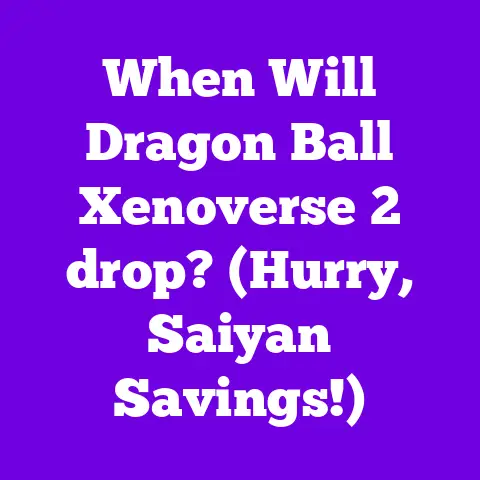When Do Grocery sales Start? (Score Deals Now!)
Grocery sales are promotions offered by retailers to entice customers to purchase specific items, often at reduced prices. These sales can significantly impact consumer behavior, influencing what we buy, when we shop, and how much we spend. In today’s fast-paced retail environment, the opportunity to save money through grocery sales is more important than ever, especially with rising food costs.
In this article, I aim to help you uncover the timing of grocery sales, explore seasonal patterns, and develop strategies to capitalize on these trends. Whether you’re a busy parent trying to stretch your budget or an individual looking to save a few extra bucks, understanding when grocery sales start can help you score the best deals.
Understanding Grocery Sales
Grocery sales are promotional events that offer discounts on various products. These sales are significant in the retail industry, as they not only drive customer traffic but also help retailers manage inventory and respond to consumer demand. Understanding the different types of grocery sales can empower you to make informed shopping decisions.
Types of Grocery Sales
-
Weekly Sales: Most grocery stores operate on a weekly sales cycle, typically starting on Sunday and running through Saturday. During this time, selected items are marked down, enticing shoppers to buy.
-
Holiday Sales: Major holidays like Thanksgiving, Christmas, and Independence Day often prompt grocery stores to offer special promotions. These sales can include discounts on festive foods, beverages, and party supplies.
-
Clearance Sales: As products approach their expiration dates or seasonal items become less relevant, grocery stores often place them on clearance. This is an excellent opportunity to save on items that may still be perfectly good to consume.
How Grocery Stores Determine Sales Timing
Retailers take various factors into account when determining sales timing. These include:
-
Inventory Levels: Stores analyze their stock frequently. If a particular item is overstocked, they may initiate a sale to clear space for new products.
-
Seasonality: Certain products are more popular during specific seasons. For instance, you’ll see sales on grilling items in the summer or hearty soups in the winter.
-
Consumer Demand: Grocery stores monitor shopping trends and consumer preferences. If a product is gaining popularity, they may offer a promotion to capitalize on that interest.
By understanding these dynamics, you can better anticipate when sales are likely to occur and plan your shopping trips accordingly.
Seasonal Trends in Grocery Sales
Grocery sales follow distinct seasonal patterns throughout the year. By recognizing these trends, you can align your shopping habits with the best times to save. Let’s break down the seasonal trends in grocery sales, month by month.
Winter
As the holiday season wraps up, many retailers offer post-holiday sales in January. This is a great time to stock up on festive foods and party supplies. You might also notice discounts on winter produce such as citrus fruits that are in season.
Additionally, January often brings promotions for health-conscious items as people embark on New Year’s resolutions. Expect to see sales on fresh produce, lean meats, and health foods.
Spring
In spring, grocery stores typically promote fresh produce and grilling items. As the weather warms up, you’ll find sales on seasonal fruits and vegetables, as well as barbecue essentials in preparation for outdoor gatherings.
Easter-related goods, such as chocolates and decorations, may also be on sale leading up to the holiday. This is also the time for spring cleaning, so expect promotions on cleaning supplies and household goods.
Summer
Summer is synonymous with barbecues and outdoor activities. Grocery stores often have sales on grilling items, picnic supplies, and summer fruits such as watermelon and berries.
The back-to-school season also begins in late summer. Stores will start to offer deals on lunchbox items, snacks, and other school-related groceries, making it a great time to stock up.
Fall
As autumn approaches, grocery stores focus on harvest sales. This includes discounts on seasonal produce like pumpkins, squash, and apples. You’ll also start to see Halloween-themed items on sale, ranging from candy to decorations.
Thanksgiving is another significant event in the grocery sales calendar. Many stores begin their promotions weeks in advance, offering deals on turkey, stuffing, and other holiday staples.
Statistical Insights
To illustrate these seasonal trends, consider the following statistics:
- According to the USDA, the average American household spends about $4,643 annually on groceries as of 2022. Strategic shopping during seasonal sales can significantly reduce this amount.
- A study by the Food Marketing Institute found that 70% of consumers plan their shopping trips around sales, indicating the importance of timing in grocery shopping.
By being aware of these seasonal trends, you can plan your shopping trips to take full advantage of sales throughout the year.
Weekly Sales Cycles
Grocery stores typically structure their sales cycles on a weekly basis. Understanding how these cycles work can help you maximize your savings.
Common Sales Days
Most grocery stores begin their weekly sales on Sunday, with flyers announcing the new deals. These sales usually run through Saturday, at which point a new set of sales begins. This weekly rhythm means that if you shop on Sundays, you can take advantage of the freshest deals right when they start.
Regional Variations
While the Sunday-to-Saturday sales cycle is common, some regions may experience variations. For example, certain grocery chains may have different sale schedules, or local markets might operate on unique timelines. This can influence shopper behavior, as consumers in different areas might prioritize shopping on different days.
Impact on Shopping Behavior
Understanding weekly sales cycles can help you plan your shopping trips more effectively. For instance:
- Stock Up: If you know that certain items are typically on sale during specific weeks, you can stock up when they are discounted.
- Avoid Last-Minute Shopping: By planning your grocery trips around the start of sales, you can avoid the last-minute rush and the temptation to buy non-sale items.
By being mindful of weekly sales cycles, you can maximize your savings and minimize impulse purchases.
Impact of Holidays on Grocery Sales
Holidays have a profound effect on grocery sales patterns. Major holidays not only influence what’s on sale but also when those sales occur.
Major Holidays and Their Influence
-
Thanksgiving: This is one of the biggest grocery shopping events of the year. Many stores start their promotions weeks in advance, offering deals on turkey, stuffing, and seasonal ingredients. Last-minute shoppers can often find great deals as stores try to clear inventory.
-
Christmas: Similar to Thanksgiving, Christmas brings about sales on baking goods, gift items, and festive foods. The week leading up to Christmas is prime time for grocery shopping.
-
Independence Day: Celebrations often revolve around barbecues, leading grocery stores to offer significant discounts on grilling meats, condiments, and picnic supplies.
Pre-Holiday Sales
Many retailers initiate pre-holiday sales to encourage early shopping. By taking advantage of these promotions, you can save money and avoid the stress of last-minute shopping.
Consumer Trends During Holidays
During holiday seasons, consumers often prioritize convenience. This means that while many people are shopping for deals, they are also more likely to make impulse purchases. Recognizing this trend can help you remain disciplined and stick to your shopping list.
With holidays being a major driving force for grocery sales, planning your shopping around these events can lead to significant savings.
Emerging Trends in Grocery Sales
The grocery shopping landscape is rapidly evolving, influenced by technology, consumer preferences, and societal trends. Staying informed about these emerging trends can help you adapt your shopping strategies.
Online Grocery Shopping
The rise of online grocery shopping has transformed how consumers approach sales. Many retailers now offer exclusive online deals, making it essential for shoppers to explore both in-store and online sales.
Social Media and Digital Coupons
Social media platforms and grocery apps have become powerful tools for consumers looking for sales. Digital coupons, promotions posted on social media, and loyalty programs provide shoppers with additional avenues to save.
Sustainability and Local Sourcing
Consumers are increasingly prioritizing sustainability and local sourcing in their shopping habits. This trend is affecting sales timing, as stores align their promotions with seasonal produce and local harvests.
Adapting to Trends
Retailers are constantly adapting to these trends. You may find that stores regularly update their sales strategies to appeal to tech-savvy consumers or those interested in sustainable practices.
By staying aware of these emerging trends, you can make informed decisions about when and where to shop for the best deals.
Strategies for Scoring the Best Grocery Deals
Now that we’ve explored when grocery sales start and the factors influencing them, let’s discuss practical strategies to help you score the best deals.
Plan Your Shopping Trips
One of the best ways to take advantage of grocery sales is to plan your shopping trips around the sales cycles discussed earlier. By knowing when sales start, you can prioritize your shopping days and avoid missing out on discounts.
Use Technology
Take advantage of grocery apps and websites that track sales and offer digital coupons. Many apps allow you to compare prices across different stores, ensuring you get the best deals.
Make a Shopping List
Having a shopping list can help you stay focused and avoid impulse buys. Stick to your list, especially during holiday seasons when there are many tempting promotions.
Sign Up for Loyalty Programs
Many grocery stores offer loyalty programs that provide exclusive discounts and rewards. Sign up for these programs to take advantage of additional savings.
Be Flexible
While it’s essential to stick to your shopping list, being flexible with your choices can lead to greater savings. If an item on your list isn’t on sale, consider purchasing a similar product that is discounted.
Conclusion
In conclusion, understanding when grocery sales start and how to navigate seasonal trends can be a game-changer for your grocery budget. From weekly sales cycles to holiday promotions, the timing of sales plays a crucial role in consumer shopping behavior.
By implementing the strategies outlined in this article, you can maximize your savings and make more informed purchasing decisions. So, the next time you head to the grocery store, remember that timing is everything. By being aware of when sales start and planning your shopping trips accordingly, you’ll be well on your way to scoring fantastic deals and making the most of your grocery budget. Happy shopping!






